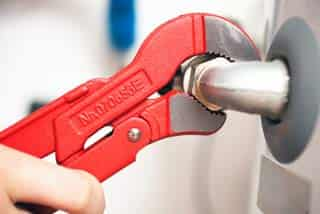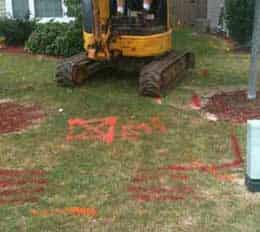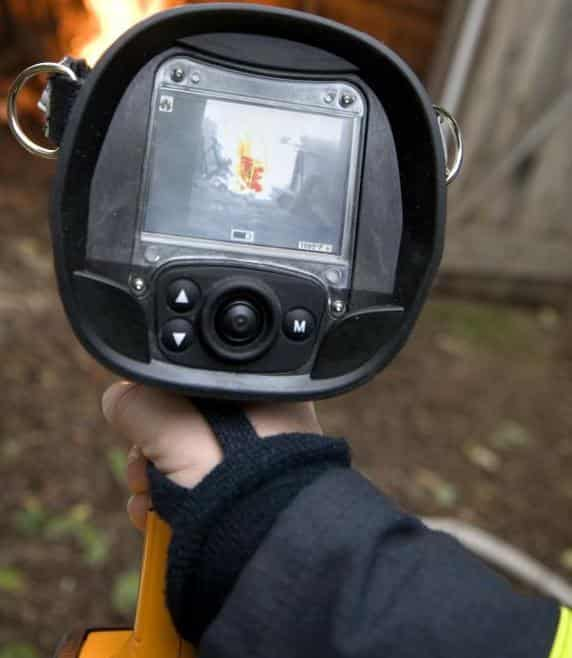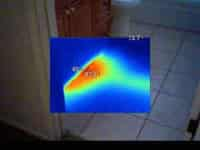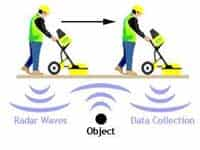Leak Detection Equipment
A number of tools exist out there that can be used for water leak detection. Some are far more advanced than others. All of them work towards letting the user figure out what's happening.
Water leaks create problems in a number of ways. They result in loss of water and higher utility bills, they create seepage and erosion loss near the leak, and they can sometimes contribute to bigger problems like sinkholes if the damage gets too big. They also contribute to further corrosion of water plumbing systems on the outside of the pipes.
Unfortunately, water leaks are not actively monitored in practice. Many times, the issue tends to be addressed when it becomes a serious problem. However, water damage has repeatedly scored second in ranking as a factor causing the most damage to businesses. Additionally, leak detection can go a long ways to saving money both on insurance and direct repair or remedy expenses.
Spot Detector
The purpose of a spot detector tool is to find the pinpoint location of a water leak in a system. This is usually done by sending some kind of a probe material through the water. This sort of approach works best where the system can be seen, i.e. the plumbing is exposed to visual confirmation. Extremely effective spot detectors also include a secondary component that sends back data communicating the leak, or loss of pressure, or some other kind of metric to identify the plumbing system weakness. Spot detectors tend to be the simplest, lowest cost approach for water leak detection, but they have limitations. They don't work so well in open water areas, used more often in confined pipe-style cavities.
Hydroscopic Tape-Based Sensor
The Hydroscopic Tape-Based Sensor (HTB) sensor approach applies a sensing tape around a water container or channel part (i.e. a pipe). When the tape gets exposed to water or moisture, it sends a signal that a leak may be present where the tape is applied. This sort of equipment is prone to false alarms, however. For example, condensation is one problem that can create moisture but no leak.
With technology more tools have become available for leak testing that provide smarter data collection and results.
Continuous Run Sensor
This type of equipment uses a cable design that runs along a water system with complex sensors. Not only does this kind of equipment signal a leak, it can potentially sense where, how much, and the size of the leak, depending on the sensor wiring and technology involved.
Time Domain Reflectormetry
This kind of equipment keeps metrics on how much signal degradation occurs when emitted from a detuned resonant circuit. This allows the discovery of multiple leaks at the same time and also allows for filtering. That said, the system has a limitation; the initial leak founds needs to be smaller than subsequent leaks found. If not, the first leak will outweigh sensing collection in the equipment. Further, quite a bit of water needs to be involved in the exposure for the TDR sensors to trigger.
Intelligent Cable Sensor
Using either non-conductive or conductive sensing wire, this type of equipment follows the same theory of a chain or cable run through a system with the ability to pick up environmental differences along the length. Non-conductive wires are used more often due to a more accurate performance and less false alarms when run through or in contact with metal materials. These cables do have the ability to adjust their sensitivity, so little issues can be filtered out to find bigger problems. Additionally, because the cable system notifies both the leak and distance along the system, leak length and extend can be identified.
Helium Leak Detection
There are many leak detection systems on the market that are designed to locate water leaks. The majority of leak detection equipment is somewhat technical, and they require the expertise of the professionals to use correctly. In addition, it is unlikely homeowners would ever buy or even try to rent the kind of equipment that the professionals use to detect leaks. Even when the homeowner does have the ability to rent or buy the equipment, the lack of experience can lead to extreme difficulty in detecting leaks in a plumbing system. Out of all of the leak detection systems available, the helium detection equipment and methods often prove to be the most accurate and effective.
Although there are a number of manufactures producing machines with slight variations, most helium water leak detection units basically function in the same way. Helium gas is pumped into a the waterline where the leak is suspected to be. Once in the pipe, the gases search for any small crack or puncture where they can escape. The levels of helium in the space around the pipe are then monitored for the presence of gas. Upon locating the point that the gas is escaping, a professional can pin-point the leak and repair the damaged section of the pipe. Homeowners do not need to worry about the presence of helium gas around their property. Helium is light, odorless, non-toxic, and non-flammable. Also, the amounts of the gas that are used in these kinds testing procedures is minimal.
When compared to other methods of tracking down water leaks, the helium technique is vastly more efficient. Other systems rely on acoustics and audio indicators. These kinds of detection units are often rendered inaccurate because of excess background noises and disturbances. Trace helium units rely on clear and precise digital read outs that are monitoring the air. If a novice takes on leak detection, they would not realize the amount of piping that is involved in their plumbing system. Locating a leak can involve covering lots of ground. To get this kind of job done efficiently, it is best left to the professionals. Their equipment will be the latest designs on the market, and their main concern will be to locate and repair the water leak quickly if you are fortunate to find a company that can do it all. Because leak detection can require a specialist, there are some companies that only offer leak detection and some plumbing contractors will actually hire those specialist to locate the leak. Once the leak is found by the leak detection specialist, the plumbing contractor handles the repair. Because some plumbing contractors specialize in leak repair and may have performed hundreds of there type of projects, they may have invested in the equipment and training to also be qualified to locate the leak and not have to sub out the leak detection. Chances are that if your plumber is using helium leak detection, they are on the cutting edge of their trade.
Regardless of the type of sensor equipment used, water leak detection needs to be able to meet certain criteria to be effective. There are a number of leak detection efficiency factors that help find the leak or the extent of damage, especially when the water system may be underground or hard to access.
Water leak testing has come a long way from where it was 20 years ago, but the results via various equipment can still be interpretive. Much depends on how the equipment is used and how disruptive stimuli can be filtered out. As people use various types of equipment more often, experience helps produce better leak identification results through skill and knowledge. Bottom line, hire a professional that is a leak detection specialist. Experienced with the right tools and latest high tech equipment, the leak detection specialist will give you the best change of finding the source of the leak.
Infrared Leak Detection Modernizing Today's Plumbing Repair
Most people think water and plumbing leak detection involves looking for water stains, moisture, mold and similar. While these methods are used, technicians also have the benefit of infrared scanning tools to help them find hidden plumbing leaks as well, especially before they become a larger problem over time.
How it Works
Technically known as infrared thermography, a technician looks over a potential leak area with an infrared imaging camera, closely examining the screen results. All objects put off radiated energy, and differences in those readings visually can signal where a leak might actually be. It is a science, however, and that require skill to properly and accurately read the camera results. Plumbing contractors that specialize in leak detection or leak detection companies know hot to interpret camera results so as to minimize mistakes.
Infrared thermography can be applied both internally as well as to the external, for outside areas. This is often performed where plumbing lines are run for custom-work or specialty renovations. Further, an inside and outside scan can literally pinpoint a leak to within inches of its source, if not closer.
Benefits
One of the big benefits of infrared leak detection is the fact that a technician does not need to perform any kind of exploratory damage to see behind walls or inaccessible areas. An infrared scanner provides the ability to see through interior walls, such as drywall. When a small leak or signs of one are found, then the repair can focus on the exact area without any impact anywhere else inside a room or structure. That reduces repair and recovery costs, which are usually in addition to the cost of repairing the plumbing leak itself.
When used properly with a trained technician, infrared thermography scanning can find a leak with 100 percent accuracy. Again, this saves the homeowner considerable costs and expenses versus exploratory evaluations and traditional leak detection. The bottom line is that this process can possibly save you time and money compared to non professional leak detection methods.
In Summary
So if you suspect a leak is occurring in your house, don't trust the job to handyman or someone drilling holes in a guessing game to find the problem. Consider using a professional plumbing firm with the right tools like infrared leak detection. You will appreciate the thoroughness of the expertise, as well as the savings from unnecessary expenses.
